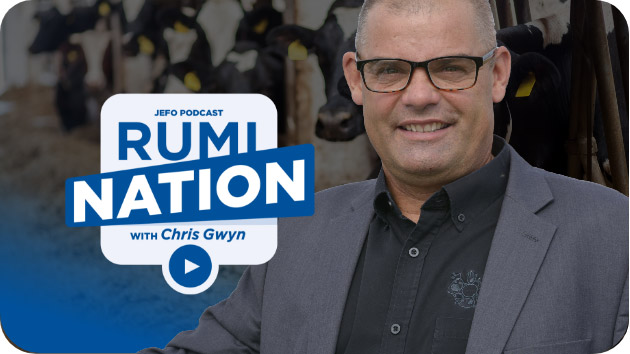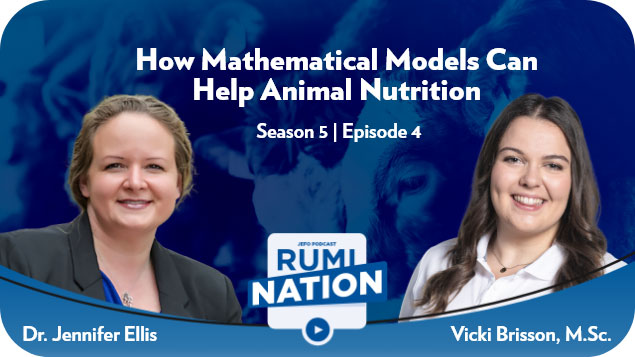RumiNation | S05 : E03
Economic Situation and Perspective within the Cattle Market
Brought to you by Jefo Nutrition
Share now!
Did you enjoy this episode?
Share now!
Our guest - Dr. Lee Schulz
Lee Schulz is an associate professor in the Department of Economics at Iowa State University and serves as the statewide extension specialist on livestock economy and markets. His areas of focus are in marketing, price analysis, and risk management for the beef cattle and pork industries.

Timestamps & Summary
Dr. Greg Eckerle (02:05)
When we see where we’re at with the cattle cycle, where do you think the next three to five years of production are going to go?
Dr. Lee Schulz
Just to give a bit of background, the cattle inventory cycle has three phases. It has expansion, has liquidation, has a turnaround phase. We’re currently in the liquidation phase. This cattle cycle started in 2014, inventories peaked in 2019, and we’ve been on a slide of inventories over the last several years. Most cattle cycles are nine to 14 years. And so, if you do the math, we’re in year nine of that cattle inventory cycle. […]
Dr. Greg Eckerle (06:33)
Have we seen any change in the way that our beef are being marketed, or what’s that in comparison to the domestic market supply?
Dr. Lee Schulz
I’ll note demand has been incredible the last several years. If you look at it internationally or domestically, it has taken a bit of a step back in the last couple of years, but you compare it to a really high base level when you think about demand. So even though we’ve taken a bit of a step back, we still remain historically in a really good demand spot. And prices reflect that along with the tighter supplies. […]
Dr. Greg Eckerle (08:48)
When we look at the domestic market and we see things happening domestically here: interest rates are on the rise, things that are affecting the American household, etc. What would we see at the retail side?
Dr. Lee Schulz
Well, I do need to commend you. You sound like an economist there, Greg, and because I think you highlight really the issue with demand, it’s not prices. So, the price of beef does not impact demand, it impacts quantity demanded, but it doesn’t impact demand. What we know impacts demand is income. […]
Dr. Greg Eckerle (11:04)
July 4 and Labor Day are historically great holidays for us protein market when we have a summer barbecue season and things like that. Have you looked at that impacting demand this year or is it going to remain relatively flat?
Dr. Lee Schulz
Well, I think you can look at the value of wholesale, the choice beef cut-out for this time of year, it’s a record high. I think that points to, yes, we have tighter supplies, but you need the demand to pull it as well. I think you’re seeing very strong demand within the wholesale and retail level that is really spurring prices. […]
I think it is really important to highlight it’s not a tight supply situation. The fundamentals there are a little bit easier to understand. We know that much tighter supplies will increase prices. […]
Dr. Greg Eckerle (12:52)
What are we going to be looking at in the fall? The best-case scenario with moisture and then maybe worst-case scenario if we maintain a drought consistency pattern.
Dr. Lee Schulz
That’s really a key question as we look at crop markets for cattle markets. […]
So, now we’re really focused on the crop development and conditions which are going to impact that new crop supply here come fall. […] If you look at the report for weekending June 12th, 61% of the nation’s crop was rated good to excellent. That’s three percentage points lower than last year. So, for benchmark it against last year, the crop isn’t as good this time of year, slightly below. It’s also slightly below the five-year average as well. […] So, we’re in a much weaker spot than we were a year ago or in really the last couple of years. […]
But I always like to remind folks we have a whole growing season in front of us. There’s a lot that has to go right and a lot that can go wrong that could impact this year’s crop.
Dr. Greg Eckerle (19:56)
Can we have an expectation to see cows kill numbers increase, stay the same, or because we’re still in liquidation, I don’t expect them to decrease, so what kind of forecast in the cow kill numbers?
Dr. Lee Schulz
I’m glad you asked this question because I think there are a couple of keyways to really look at this data. So, as you look at beef cow slaughter year to date, we’re down about 12% compared to a year ago levels for the same period. That’s almost 200,000 beef cows over that period. This comes after last year, we were up 11%, right? Almost about 400,000 beef cows. Now you look at that and say, well, we’re killing a lot fewer beef cows this year, it must mean we may be seeing that turnaround phase. But I’ll remind us that we have a lot fewer cows than we did last year. […]
Dr. Greg Eckerle (25:09)
I guess the overall evaluation of the US marketplace seems to be on the upswing then what would be some of the main challenges coming within the next twelve to 18 months?
Dr. Lee Schulz
I think the big challenge for me is costs. I think when you look at it, not only feed costs as we talked about the crop market situation and potential for a lot of lower prices or at least lower prices as we get into the fall, which doesn’t mean that our cost of gains and dollars per cow are going to decrease all that much. I think they will decrease, but we’ve added a lot of cost to this industry over the last couple of years in the form of non-feed, variable costs, fixed costs, everything really has gotten much more expensive and those are rather sticky costs. […]







